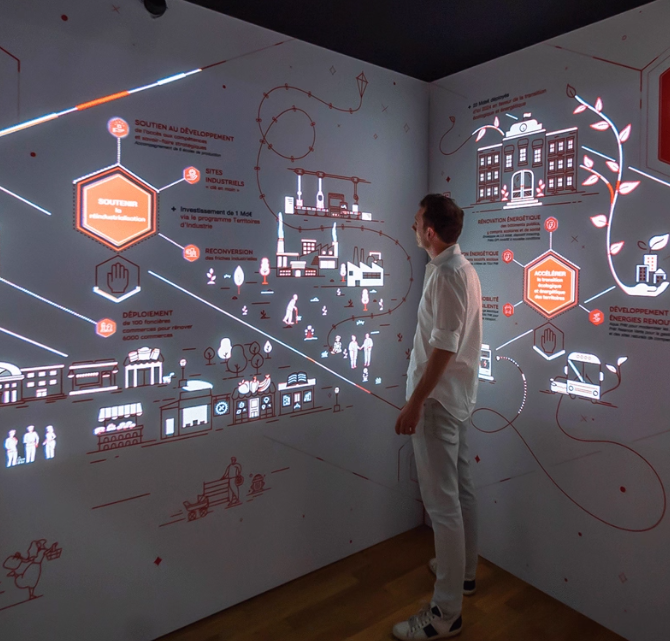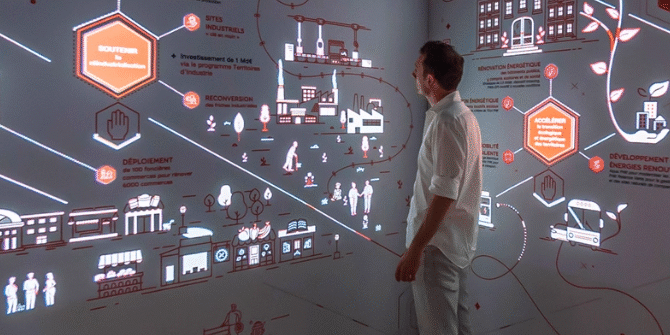Introduction
Museums are no longer just quiet halls filled with static exhibits. With the rise of interactive projection powered by POE LiDAR technology, cultural spaces are turning into dynamic learning environments. Visitors can move, gesture, and even “touch” digital content—turning a traditional exhibition into an educational adventure.
Imagine standing before a giant dinosaur skeleton and making it move with the wave of your hand, or operating a complex mechanical model virtually, step by step. This combination of education and entertainment (edutainment) is redefining how people learn in museums.

What is POE LiDAR Interactive Projection?
POE LiDAR interactive projection integrates high-definition projection with advanced motion-tracking sensors. Unlike standard projection mapping, which is passive, this system allows visitors to actively interact with virtual objects using their bodies and gestures.
By leveraging precise LiDAR-based tracking, museums can provide multi-touch, real-time engagement that makes learning both fun and memorable.
Key Features of POE LiDAR Interactive Projection
1. Gesture-Based Interaction
Visitors can use hand movements to rotate, enlarge, or manipulate virtual exhibits—whether it’s a prehistoric skeleton or a scientific diagram.
2. Immersive Storytelling
Projection across walls, floors, or 3D surfaces transforms museums into living classrooms, where content surrounds and engages the audience.
3. Educational Engagement
By gamifying learning, interactive projection encourages visitors to explore concepts hands-on, enhancing knowledge retention.
4. Real-Time Response
Thanks to CPJROBOT’s POE LiDAR, the system delivers low-latency, accurate motion tracking, ensuring smooth interaction.
Applications in Museum Education
Virtual Dinosaur Exploration
Children and adults can “control” dinosaur skeletons—activating movements, learning bone structures, and even simulating how these creatures once lived.
Complex Mechanical Demonstrations
Visitors can virtually assemble engines, operate gears, or explore scientific machines, making engineering concepts easier to understand.
Interactive History Lessons
Historical events can be recreated digitally, allowing audiences to participate in immersive timelines.
Art and Creativity
Artists can design interactive installations where museum visitors shape or influence the artwork with gestures.
Technology Behind the Experience
- Projection Systems: High-resolution laser or ultra-short-throw projectors.
- POE LiDAR Sensors: Provided by CPJROBOT, these deliver precise, multi-point detection for motion and gesture tracking.
- Interactive Software: Real-time image rendering and 3D processing power the visual experiences.
Benefits for Museums
- Boosts Visitor Engagement: Interactive exhibits increase dwell time and participation.
- Enhances Learning Outcomes: Hands-on interaction improves memory retention compared to passive viewing.
- Scalable & Cost-Efficient: Digital content can be updated quickly without physical reconstruction.
- Attracts New Audiences: Unique experiences make museums appealing to younger generations.
Frequently Asked Questions (FAQ)
Q1: How is POE LiDAR different from traditional sensors in interactive projection?
POE LiDAR provides higher precision, wider coverage, and multi-touch detection, making interactions smoother and more accurate.
Q2: Can interactive projection work in small museum spaces?
Yes. Systems are highly adaptable, from single exhibit installations to full-room immersive environments.
Q3: Is the technology suitable for educational purposes?
Absolutely. Interactive projection merges play and learning, making complex subjects easier for students to grasp.
Q4: What maintenance does the system require?
With robust projectors and industrial-grade sensors, maintenance is minimal. Content updates are digital, reducing long-term costs.
Conclusion
POE LiDAR interactive projection is transforming museums into spaces where learning feels like play. From exploring virtual dinosaurs to operating mechanical models, visitors can engage with knowledge in ways that are immersive, interactive, and unforgettable.
As a trusted manufacturer of POE interactive LiDAR and reception/navigation robots, CPJROBOT empowers museums and cultural institutions to embrace digital transformation.
Ready to create unforgettable educational experiences in your museum?
Contact CPJROBOT today and explore custom interactive projection solutions.







